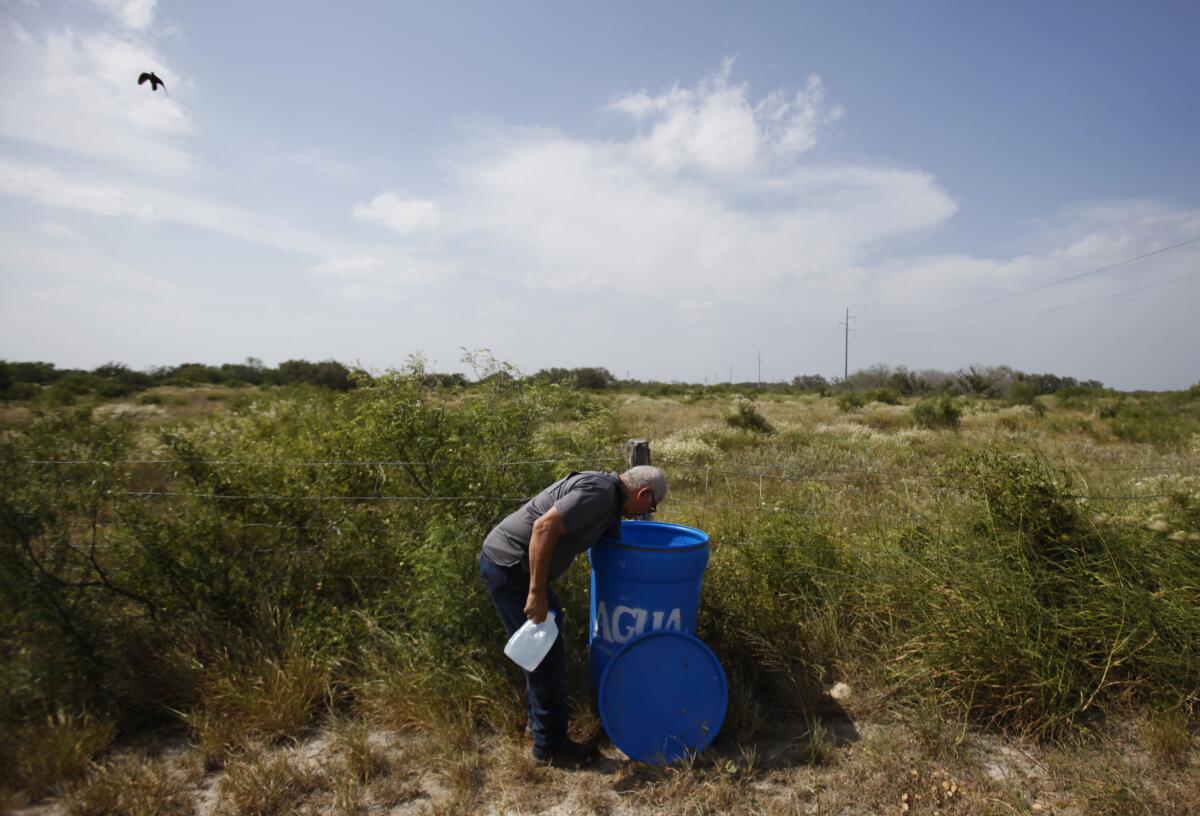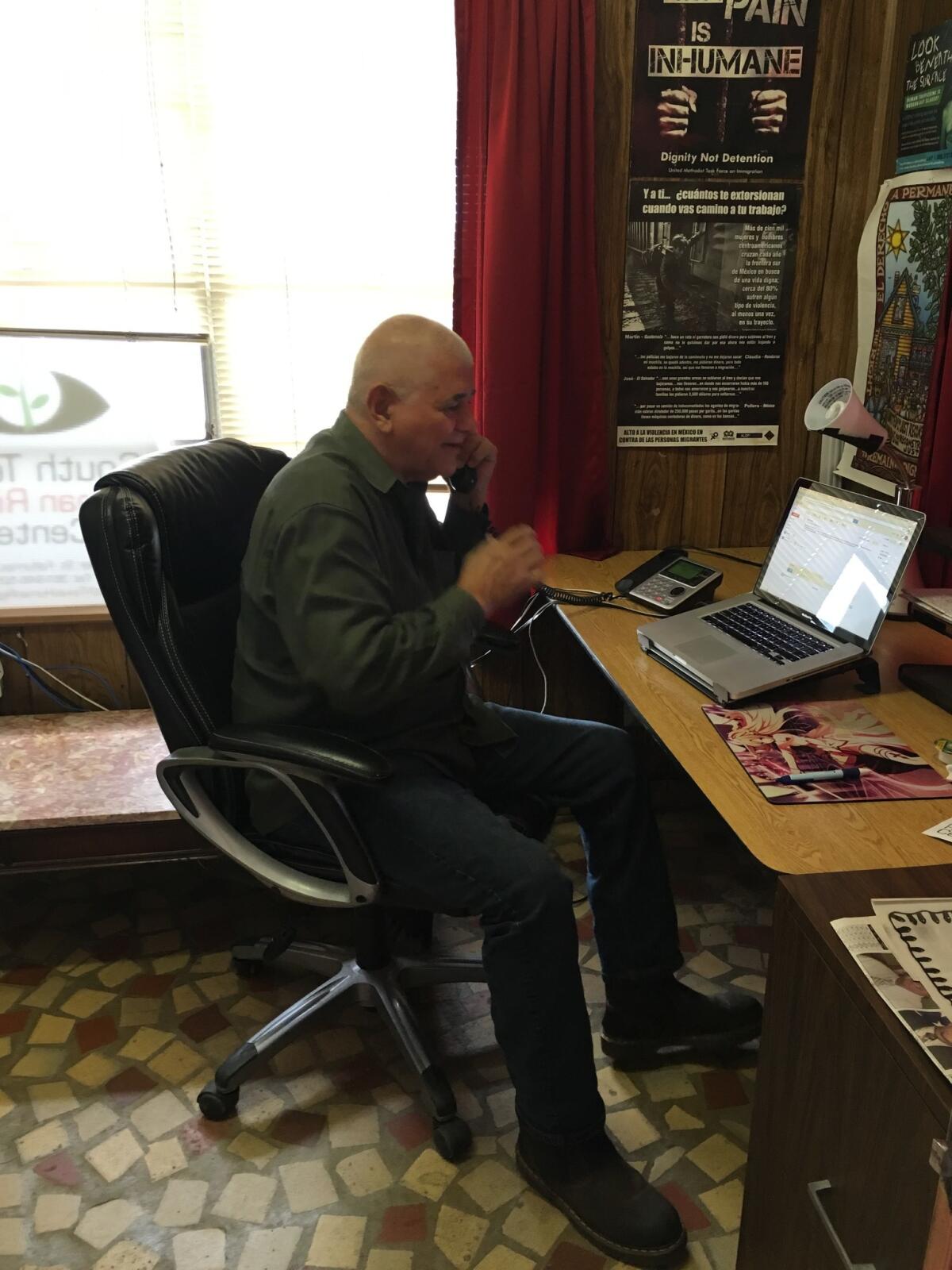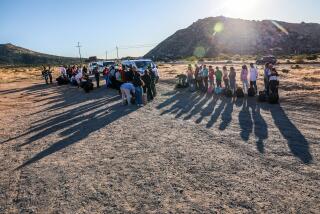Amid holiday cheer in Texas, the grim task of finding missing migrants

Eddie Canales of the South Texas Human Rights Center, prepares a water dispenser for immigrants walking across the scorching scrublands of southern Texas.
Reporting from Falfurrias, Texas — It’s time for the South Texas Human Rights Center holiday open house to start, guests due any minute, fragrant tamales heating in a crock pot, but Eddie Canales is still on the phone.
His manner is serious, concerned, as he takes notes on an index card.
“When did he cross the river?” Canales asks in Spanish. “Did he come alone?”
The man called, like many do, from out of state, from Maryland. He is searching for a relative who crossed the border illegally. Like so often these days, the missing man is Central American, Honduran. The caller tells Canales he believes Daniel Osorio, 25, entered Texas on Dec. 5 and headed north, toward the ranch land of Brooks County.
About 70 miles north of the border, the county is a popular drop spot for smugglers because the Border Patrol checkpoint south of Falfurrias on Highway 281 screens traffic heading north to San Antonio and Houston. Smugglers stop short of the checkpoint to leave loads of immigrants in the brush. Go north, the smugglers say. We’ll pick you up later.
Canales assures the man he will start searching for his lost brother.
“Yesterday afternoon was the last they heard from him,” Canales says. “He was lost on a road with a lot of dust.”
Join the conversation on Facebook >>
Guests start to arrive for the open house, filing in past lights strung around trees outside: ladies from the Women, Infants and Children office next door, staffers from the library across the street, the sheriff’s office and the Honduran consulate, one with a Christmas light necklace. The district attorney comes from the courthouse across the street. So does a Border Patrol agent.
The occasion is the holiday season, but the room abounds with reminders of the nonprofit center’s often grim work. The guests peruse signs tacked to the wall that explain in Spanish how families search for lost loved ones, sometimes relying on DNA to identify remains of those who perished in the brush.
They know Canales has found lots of bodies, some within a dozen miles of Falfurrias’ Main Street. This gathering on Dec. 18 is also in honor of International Migrants Day, he tells his guests. He reminds them how he works with the Border Patrol, the sheriff and ranchers to respond to migrants’ 911 calls, triangulating their locations.
Canales recalls how one rancher recently spotted him in town and thanked him for his work. Yes, one of the ladies says, I know that rancher — I used to hunt on his property all the time.
They notice a sign over Canales’ desk. He has built so many water stations for migrants, a supporter who has a station by her hunting lodges gave him a carved wooden nameplate that reads “Waterboy.”
The phone rings again.
It’s another family worried about a missing migrant. This one is Salvadoran. Mario Antonio Pineda, 39, disappeared a day earlier.
Canales tells them to email him their information and shakes his head.
“People don’t know where people are at,” he says. He returns to the party.
He is wearing his usual dusty cowboy boots and jeans. But his hair is newly crew-cut, and he’s added a freshly pressed white guayabera shirt for the party. The room is decorated with a miniature tree and Mexican holiday streamers. They are strung past dioramas explaining the center’s mission to save missing migrants and identify the dead. Some guests ask for brochures.
Canales serves the beef, chicken and pork tamales, soup made from local Nilgai antelope and lime-flavored Topo Chico mineral water. As he does, he tells the visitors about the work he has been doing with help from staff and volunteers.
Last spring, they assisted authorities in Houston with a “Missing Day” to try to identify remains, including 28 found in south Texas; five of whom have since been identified. They have another Missing Day planned soon.
The ladies from the consulate talk about Honduran officials’ efforts to deter migrants from making the trip north. They have started jobs programs and try to persuade their countrymen that it is more dangerous to leave Honduras than to stay, a challenge in a country with one of the highest homicide rates in the world.

Eddie Canales of the South Texas Human Rights Center fields another phone call from someone trying to find a missing relative who crossed into the U.S. illegally.
The consulate workers finish their meal and pull up a photo on their phones. It’s the body of a Honduran migrant found recently in south Texas. Her face is a rotted green mask covered in larvae. She was four months pregnant, they say.
Canales tells them about the water stations. Lately, someone has been vandalizing them, discarding the water jugs and stealing the towering orange flags that help migrants spot them amid the tall chaparral.
“They’re trophies,” he says. “And the flag is the most expensive part!”
This year, officials and volunteers in Brooks County have recovered 45 migrants’ remains, Canales says. Last year, they found 61.
Well, that’s good, the guests say.
Not necessarily, he replies, frowning. He suspects there may be more bodies out there somewhere.
Since this fiscal year started in October, Border Patrol has rescued 136 migrants in the Rio Grande Valley — up from 115 this time last fiscal year.
But Canales is skeptical of that figure, too.
He picks up the local newspaper, the Falfurrias Facts, and points to a headline next to a photo of migrants caught while being smuggled in a tractor trailer. It uses local shorthand to refer to the Rio Grande Valley: “RGV Sector Border Patrol Rescues Six Immigrants.”
“But that’s not a rescue!” the women from the consulate protest in Spanish.
Canales has other reasons to believe there are more migrants’ bodies awaiting discovery out on the ranches: “The calls I’m getting.”
He receives up to 50 inquiries a month. A hotline in Arizona that fields mostly calls for missing migrants in Texas is receiving about 100 calls a month, he says. His guests shake their heads.
Soon after, they say their goodbyes, offering Christmas greetings as they file out into what passes in south Texas for a cold winter afternoon, the high 60s. Canales is quickly back at his desk.
There’s a chance that the men whose families called earlier are not dead, he says. They could be in immigration custody, like another missing migrant Canales located a day earlier. And so he is calling Border Patrol to ask about Daniel Osorio and Mario Antonio Pineda. If that doesn’t work, he will gather clues provided by the families that might be used to identify any new sets of remains.
In a few days he will leave the office for a short vacation and won’t return until the New Year. But as usual during the holidays, Canales will still be taking calls.
For news from the border region, follow @mollyhf on Twitter.
ALSO
A Syrian Christian, seeking asylum, wonders why he’s in custody in Texas
Who were the Syrians who showed up at the Texas border? Some are Christians
Supreme Court scheduling order in Obama immigration case bodes well for a faster ruling
More to Read
Sign up for Essential California
The most important California stories and recommendations in your inbox every morning.
You may occasionally receive promotional content from the Los Angeles Times.











